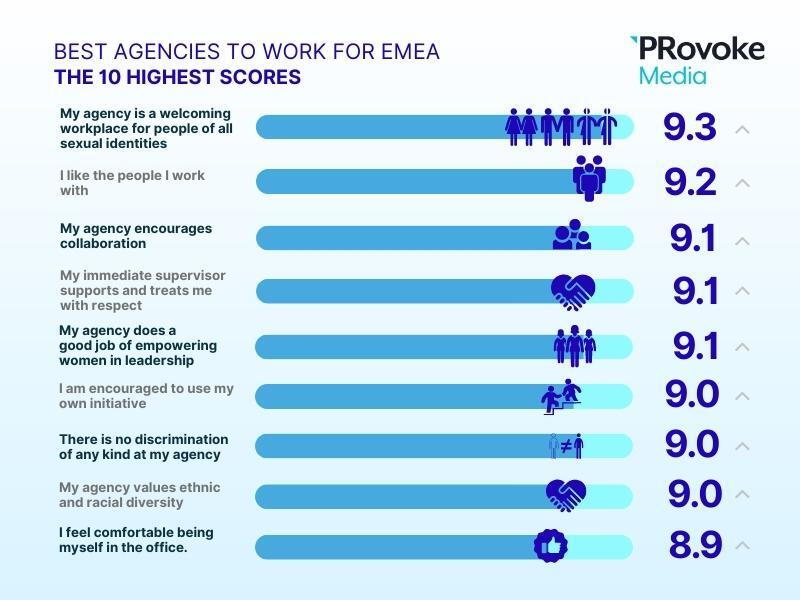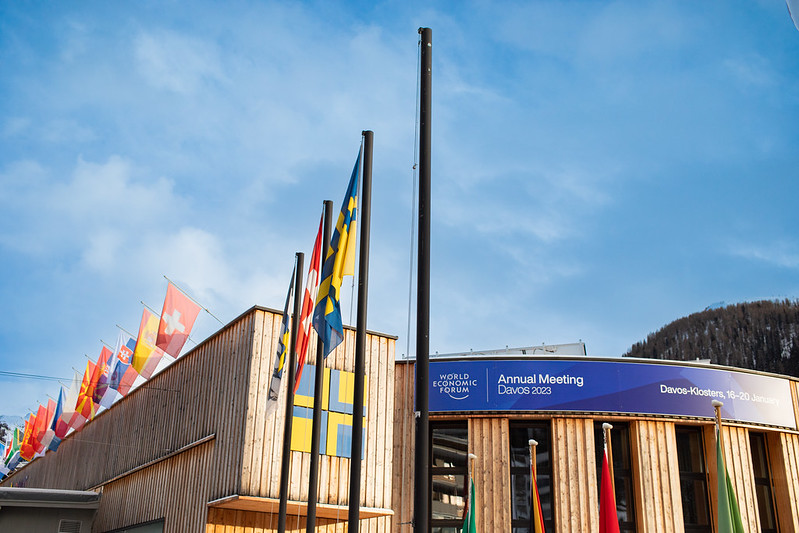Paul Holmes 25 May 2023 // 6:57AM GMT

There are two things that public relations agency employees on both sides of the Atlantic value more than financial compensation, according to our Best Agencies to Work For research: work-life balance is one, and their agencies’ people and co-workers is the other.
In North America, agency employees now say that work-life balance is their number one priority when it comes to overall job satisfaction, ahead of people and co-workers, with financial compensation and other benefits number three on a list of 11 different priorities.
In EMEA, financial compensation and other benefits rank only fifth on the same list of 11 priorities, behind people and co-workers (number one), work-life balance, workplace culture, and interesting and rewarding work.


It may be that people don’t like to think of themselves as motivated purely by money, which can skew the results of a survey like this one. But there’s no doubt that work-life balance has taken on greater significance since the pandemic, the “great resignation,” “quiet quitting” and the return to the office over the past year or so — although employees seem to feel that the latter process has been well-managed.
It is also worth noting that while work-life balance is often thought of as a priority for younger employees, it was consistently the number one or two choice across all age groups, and across gender and ethnicity, ranked consistently higher than financial compensation among all demographics in our survey.

The bad news for agency leaders is that their firms do not score high marks on questions related to work-life balance. Survey respondents were asked to rate their own agencies on a scale of one to 10 on 42 different statements. “My firm does what it can to avoid long hours and undue stress” received the third lowest score in North America and the second lowest score in the UK and EMEA.
“My firm cares about the physical and mental well-being of its employees,” another statement in the work-life quality category, scored 35th out of 42 categories in EMEA and 31st in North America. “My firm offers appropriate options for flexible working” is an area where firms scored better — at least in North America, where it ranked 17th out of 42 questions, considerably better than in EMEA, where it ranked 31st.


There is somewhat better news when it comes to people and co-workers. “I like the people I work most closely with” was the fifth highest scoring statement for North American respondents, and the second highest scoring statement in EMEA. More troubling is the fact that “my agency does a good job of retaining good people” was among the 10 lowest scoring statements in both regions.
Unsurprisingly, a statement about compensation — “I am happy with my financial compensation” — ranked dead last in both regions. “Overall, my compensation and benefits are fair compared to other agencies,” was another statement with low scores (37th in North America, 40th in EMEA) — although the fact that every agency scores relatively poorly on this statement suggests an element of “the grass is always greener” in employee thinking.
DE&I challenges remain
Another major — and unsurprising — finding from the survey was that agencies still have a lot of work to do on diversity, equity and inclusion.
First, the raw numbers: in North America, just over three-quarters of respondents identified as white (75.5%); 5.9% identified as Latino or Hispanic; 5.6% identified as Asian or Asian-American; 3.9% identified as mixed/multiple or other races; and 3.1% identified as Black or African-American. Considerably fewer than 1% identified as either Amerian Indian, Alaska Native, Native Hawaiian or other Pacific Islander. (Around 5.8% declined to answer the question.)
Obviously, these numbers are disappointing, with fewer than 19% of respondents to our North American survey identifying as BIPOC. If this is an accurate reflection of the industry as a whole (and the usual caveats about sample size and self-selecting samples apply) these numbers do not reflect the country we live in or the stakeholder groups we must communicate with. They don’t even reflect the numbers that have been publicly disclosed by agencies.
The representation of Black or African-American employees in our industry is particularly troubling. More than 12% of the overall US population identifies as Black. If representation in the PR industry is really just over 3%, then urgent action is needed — more urgent and more proactive than anything we have seen to this point. All the goodwill in the world is irrelevant if we are not able to deliver meaningful change.
In the UK, numbers were no better in terms of reflecting the overall population. Just 4.6% of respondents identified as Asian or British Asian; 4.8% identified as Black, African or Afro-Caribbean; and less than 1% identified as Middle Eastern or North African. The largest category of non-white respondents was “mixed/multiple” (6.1%) while 1.4% identified as “other minority.” With 3.3% declining to answer the question, that left at least 79.6% of the responding sample identifying as “white”.
(Numbers for EMEA were difficult to calculate because of smaller sample sizes and the fact that the region includes markets such as the Middle East and Africa as well as Germany and Spain, skewing the sample in ways that are difficult to break out this year.)
In North America, employees appear to recognize that their agencies have more work to do on the DEI front. “My agency values ethnic and racial diversity” ranked 21st out of the 40 statements we asked about, while “There is no discrimination of any kind at my agency” ranked 22nd.
Interestingly, on both statements the overall BIPOC scores were higher than those for the survey as a whole, while Black respondents rated their agencies slightly worse than the overall survey. So when employees were asked whether their agency values ethnic and racial diversity, the overall score was 8.83, while the score from BIPOC employees was 8.93, and from Black employees 8.66.
Two things to note are first, that these scores remain high across all ethnic groups. A score of close to 9 on any metric suggests most employees are broadly happy with their workplaces. But the lower numbers from Black respondents do suggest that they are not quite as satisfied as their colleagues when it comes to the way agencies are addressing diversity issues.
In the UK, however, employees seemed considerably more satisfied with the way their agencies deal with DEI issues. “There is no discrimination of any kind at my agency” recorded the seventh highest score of the 40 questions on which employees were surveyed, while “my agency values ethnic and racial diversity” was the eighth highest ranked statement.
And once again, diverse employees were likely to give their agencies slightly lower marks on those two dimensions, compared to respondents who identified as white. On the question of whether their agencies valued ethnic and racial diversity, for example, diverse employees gave an overall score of 8.95, compared to 9.00 for respondents as a whole.
Gender studies
In both North America and EMEA, agencies received the highest marks in response to the statement “My agency is a welcoming space for people of all sexual identities.” In North America, the average rating on this statement was 9.35, while in EMEA it was 9.31.
With all the usual provisos about sample size and a self-selecting set of agencies, it does appear that the public relations agency business has created a “safe space” for the LGBTQ+ community. There is widespread satisfaction among agency employees with their firms’ approach to sexual identity. But we should also note that we did not ask people to provide information on sexual identity so we cannot this year isolate responses from the LGBTQ+ community — although any widespread concern would surely show up in the overall numbers.
There was also broad satisfaction with the way agencies are empowering women. In North America, the statement “my agency does a good job of empowering women in leadership roles” scored the fourth highest marks of any of the 40 statements (9.22) and in EMEA it scored the fifth highest out of all statements (9.16).
Moreover, on some of the generalized questions, women scored their firms better than survey respondents as a whole. For example, when asked whether they would recommend their company as a great place to work, women in North America responded with an average score of 9.11, compared to 9.06 for respondents as a whole. In EMEA, women gave their agencies a score of 8.98 on the same question, compared to a score of 8.92 for respondents as a whole.
So in both North America and EMEA, women are generally pretty happy with the opportunities they receive at their agencies, and with the ways in which their agencies empower female leaders. Having said that, it will be interesting to see what our analysis on the gender pay gap, which will be published in the next few weeks, has to say about whether women really are valued highly by their agencies — or are simply settling.
One thing is clear from the survey: the industry continues to be dominated by women at the entry level — but loses a lot of female talent as time goes by.
In North America, the profession — at least the portion of it responding to our survey — is 76.8% female and 22% male (with a little more than 1% of respondents identifying as non-binary/other). But the proportion of women declines by age: at 26 or younger, the agency business is 84.8% female; from age 27-33 it is still 82.8% female; by 34-40 it has declined slightly to 77.6%; at age 41-47, it is 66.1% female; at 48-54, women make up 60.1% of the agency workforce; and at age 55 and over, the numbers are almost even, with women making up 53.8% of agency employees.
It is possible to believe two things at once when it comes to these numbers, I think. The first is that the PR agency business might want to do a better job of appealing to male applicants at the entry level. The second is that it can still do a better job of providing the kind of flexible career development options that might lead to a lower rate of attrition among female employees.
It’s impossible to know from this survey how many women leave the profession voluntarily, but it is surely possible for agencies to offer more options that would allow women who take a break for childbirth and motherhood to return to the workforce.
Gender inequities are not nearly as stark in EMEA. Overall, respondents to the survey were 66.4% female, 32.4% male, with around 1.2% choosing a third/nonbinary option. In the under 26 age group, the industry is 70.9% female, while in the highest age range (55 and over) the proportion of women has declined to 58.9%. It is possible that Europe’s more progressive approach to maternity — and paternity — leave contributes to the fact the number of women does not decline as steeply.
Random observations
1. The firms in our survey (and again, it is necessary to point out that this is a self-selecting sample) suggest that overall satisfaction in the public relations agency business is pretty good.
In North America, the agencies in our survey have a net promoter score of more than 70. That number is based on responses to the question “how likely would you be to recommend your agency as a great place to work?”. Employees who score their agency 6 or lower are counted as detractors; those who score their agency a 9 or 10 are counted as promoters (all others are neutral). NPS is calculated by subtracting the number of detractors from the number of promoters.
According to Bain & Company, where NPS was created, a score above 0 is good, above 20 is great and above 50 is amazing. Anywhere above 80 is the top percentile. The PR agency business does not quite qualify as amazing, but with 5.9% of employees registering as detractors and 76% registering as promoters, the overall score of 70.1 is very impressive.
In EMEA, scores are a little lower. With 7.6% of employees registering as detractors and 73.6% registering as promoters, the overall NPS for EMEA public relations firms is still a very respectable 65.9.
2. Interestingly, considering the public relations industry is widely regarded as a communications business, “good internal communication” is considered the least important dimension in the workplace by respondents in both North America and EMEA, ranking 11th out of the 11 dimensions employees could choose from in both regions.
In EMEA, “high ethical standards” was the second lowest dimension of agency leadership, while in North America “professional development” scored the second lowest of the 11 dimensions.
3. In North America, “I enjoy the work I do” was 30th out of 42 questions (8.63 out of 10) and “I believe the work I do is important and beneficial” was 34th (8.55). In EMEA, agencies fared better on both of those questions: “I enjoy the work I do” was 22nd (8.59) and “I believe the work I do is important and beneficial” was 33rd (8.39).
“These scores are pretty good, taken alone,” says Holmes. “But agency leaders might want to take a little extra time to let employees know that their work makes a difference, and their counsel helps companies do more good in the world. Public relations is tough work, but it should be fun, and PR people should be reminded how important their contributions are.”
4. Office politics and bureaucracy remain significant challenges for even the best run agencies. In North America, “my agency has eliminated unnecessary bureaucracy” was the second lowest scoring statement (7.98) and “I never have to worry about office politics” was the fourth lowest score (8.14). In EMEA both of these statements drew responses that placed them in the bottom 10.
“My agency does a good job of retaining good people” was another question that scored low marks in both surveys.



































.jpg)






























